The tempter came to Him and said, “If You are the Son of God, tell these stones to become bread.” –Mt 4:3
It doesn’t look very comfortable to me. But on this stone, enshrined in the Monastery of Quarantal, Jesus is said to have sat to pray during His forty days in the wilderness.
This stone is particularly associated with the first temptation, to which Christ gave the reply, “It is written, ‘Man does not live on bread alone, but on every word that comes from the mouth of God.’”
You may have noticed by now that the rocks I cover in this book all get the benefit of the doubt. I tend to believe in their authenticity, or at least in the traditions that underlie them. Where did these traditions come from? Does it ring true that someone just made them up? Jesus wasn’t a private man; He came to earth to reveal Himself, to let people in on the details of His life. Surely it is entirely possible that He showed someone the very stones the tempter had challenged Him to turn into bread, adding, “And here’s the rock I was sitting on when the devil approached Me.” In any case, if He didn’t sit on this rock, then He sat on another; there were no chairs in the wilderness.
I used to live beside a rushing mountain river. In spring the water level rose quite high, so the banks had been riprapped with granite boulders. I enjoyed sitting by the water, as close as I could get, and letting that glorious sound wash over me. I had a favorite rock, one that conformed beautifully to my body, as if made just for me. It’s amazing how comfortable a rock—the right rock—can be. And there’s something consoling about that, about finding a place of your own in the wild, a perfectly natural place with nothing manmade about it. Think of all the forces of nature that have contributed to forming such a place over eons—and it happens to be just right for you. It almost seems a sign of divine favor, as though the cosmos is not alien but enfolds you as a friend.
In a way, it is possible to have a relationship with a rock. There can be something there that gives back to one. A rock may even speak, saying, perhaps, in the words of Max Ehrmann’s Desiderata, “You are a child of the universe, no less than the trees and the stars; you have a right to be here.” A rock can be a word that comes from the mouth of God. Did the Stone of Temptation, perhaps, speak to Jesus? Did it help to ground and strengthen Him as He confronted the devil? Did it minister to Him as much as the angels did? Did it feed Him?
If nothing else, the totally natural quality of rocks—their wildness—like everything in nature can be cleansing to the soul. One time when my flight was delayed at London’s Heathrow Airport, I spent some time in the Multi-Faith Chapel, where I discovered a “Wadu Stone.” A smooth gray rock on a wooden pedestal, it was accompanied by the following information from a Muslim cleric: “Ritual purification is a prerequisite for Muslim prayer. If water is not available one may turn to earthly clean objects such as stone or sand. Two hands are placed on the stone and then passed over the face. The hands are then placed back on the stone before being passed over the back of each hand.”
In the various gospel accounts of Jesus’ forty days in the wilderness, one verse intrigues me above all: “He was with the wild animals, and angels attended Him” (Mk 1:13). As much as I love this juxtaposition of angels and animals, I’d like to add two words to this verse: and rocks. My Jesus is a man who valued common things and proclaimed them of priceless worth. I imagine Him finding solace in rocks, even more than if He had turned them into bread.
(Photo by Karen Mason)
Next Week: Christ Our Rock
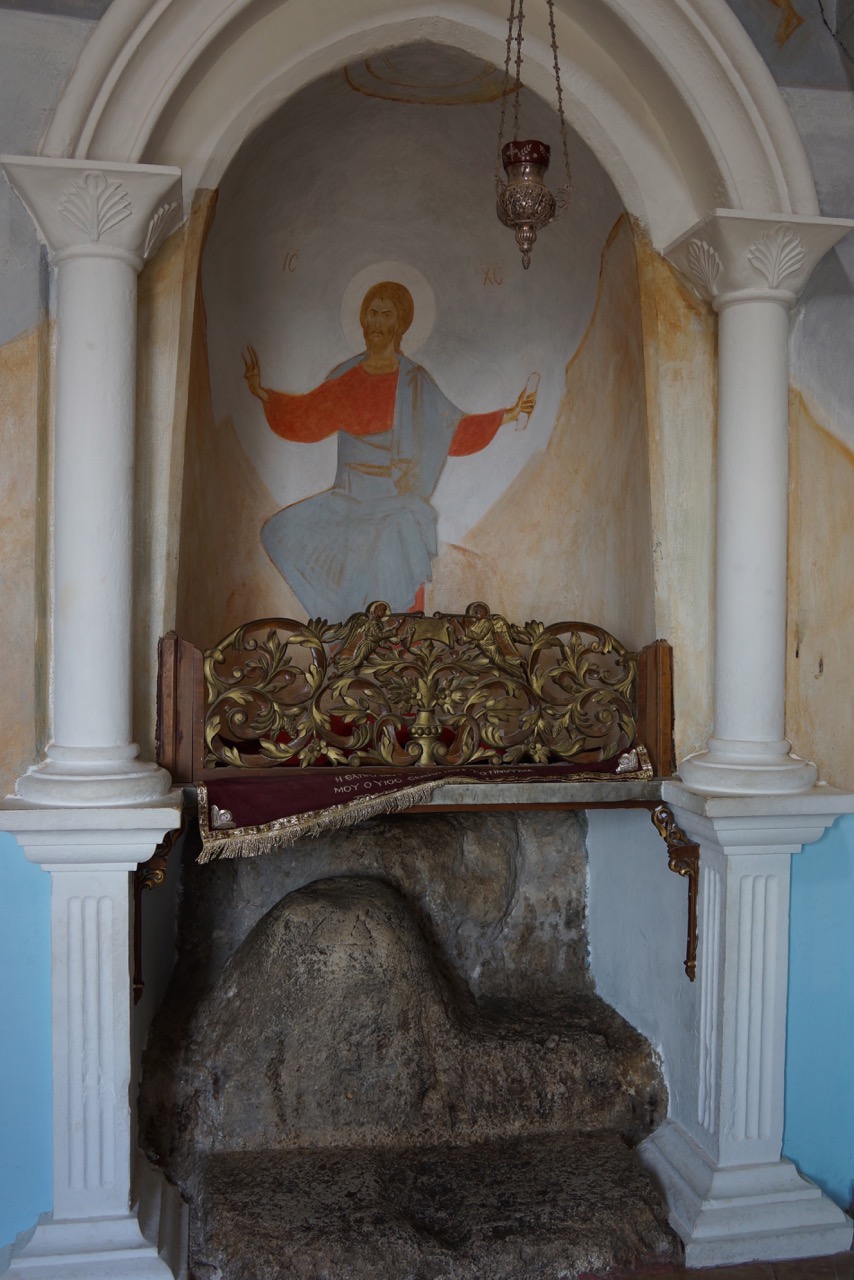

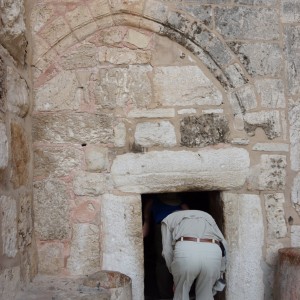
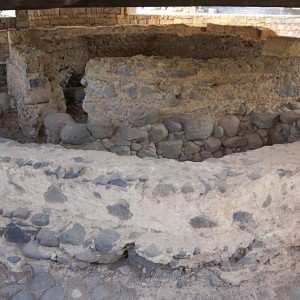
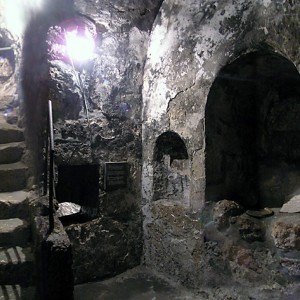
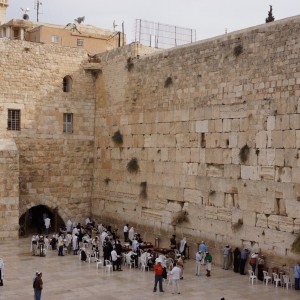
That’s amazing Mike. I followed your suggestion and I’m waiting for your answer by e-mail. See you soon. Take care.
Thanks for your comments about my writing. I do aim for a style and a vocabulary that encourages the reader to slow down and take notice. I’m an artist, and my medium is words, and I’m using words to glorify God, so there has to be something striking about the style, not just about the content. The Gospel According to Job is probably my most difficult book. After all, Job itself is a difficult book! If you want something a little easier, I recommend Champagne for the Soul. I think that would be a good book for you. It’s about living in joy.
I’m a full time writer. In my 20’s I did a lot of other jobs to support my writing. But since then, for over 30 years I’ve never had another job. I’ve done some speaking, but usually I try to avoid other commitments in order to focus solely on writing, which is my great love. There’s never enough time to write all the ideas I have! I write about 3-4 hours a day. But of course, the writing life requires a lot of other time for reading, research, reflection, planning, and prayer. Prayer especially. Although I’m married, I consider myself a kind of monk, and prayer is my first priority. I give God as much time as He wants, and then the rest of my life lives itself.
A suggestion: Follow this link to sign up for my email list. That way, I’ll have your email address and we can correspond by email. You’ll receive my weekly blog in your email box, but you can cancel that if you like. I’m currently publishing a new book online, one chapter a week for 70 weeks, called Jesus: His Story In Stone.
Your English is very good!
Hi Mike!
I see that you publish new articles very often, you’re very productive 🙂 I can say that I read one of your books called, “The mystery of marriage”, I really liked it, this book is very deep and this is the single book which was translated into Russian. I’m reading “The gospel according to Job” and find it very serious as well and let me add that your style of writing is very interesting, but, to be honest, it’s not easy for me to read it, I’m not perfect at English despite the fact that I teach it to teenagetrs and adults 🙂 Back to your English, you use very unusual words and stylistics which makes the reading of your book really interesting and absorbs me not only spiritually, but at the same time gets me interested in your style of writing and the way you use grammar and words.
Could you tell me about your daily life if you don’t mind? Are you just a writer or do you preach in a Church or work somewhere else?
God bless you too Mike!
Yes, I’m happy to hear from you. God bless you!
Thank you very much Mike! Is it OK if I’ll write to you sometimes?
I understand your confusion. I don’t think it’s helpful for John MacArthur to paint the Muslim religion completely black. There is actually a good deal of truth and beauty in Islam. But the one great difference between the two religions is Jesus. Islam believes Jesus was only a prophet, but Christians worship Him as God incarnate. Islam insists on one God, as we do, but the Christian God exists as three persons: Father, Son, and Holy Spirit. Jesus is God Himself in the flesh, “for in Christ all the fullness of the Deity lives in bodily form” (Eph 2:9). Islam has the Koran, but we have the New Testament, an infinitely greater revelation. When you feel confused, read the New Testament, especially the gospels. Focus on Jesus, worship Him, love Him, talk to Him. Ask Him to give you clarity and peace. When you doubt, ask Him to speak to you or reveal Himself. Whatever is true in Islam, it is because all the best in that religion points, without realizing it, to Jesus. In recent years there have been many, many stories of Jesus appearing to Muslims in dreams and converting them. “This is how you can recognize the Spirit of God: Every spirit that acknowledges that Jesus Christ has come in the flesh is from God, but every spirit that does not acknowledge Jesus is not from God” (1 John 4:2-3). So keep your faith simple and focus on Jesus. He is the Prince of Peace; the Light of the World; the Way, the Truth, and the Life. And I will pray for you. Amen.
Hello Mike!
If you don’t mind I ask you one more time. I’ve heard about Islam a lot recently that this religion has some things in common with our faith and decided to take a look at what they believe. I did it and also heard a sermon by John MacArthur about Islam and he says that muslim prophets and muslim jesus are antichrist and liar prophets, that all things in Islam are on the contrary to the Bible. So, Mike after hearing it I started feeling bad. When I hear about something that are wrong, I try to prove why this or that thing is wrong and this kind of proving doesn’t work for me, I mean I start having thoughts like, “What if muslims are right” and so on. So, if most of the people hear stuff like that they just ignore it or don’t pay too much attention on it, I on the contrary, start proving and analyzing things to death and it’s becoming like self-torture, all these proves don’t help me. I know that the Bible warns us in Hebrews 13:9 “Do not be carried away by all kinds of strange teachings…” I’ve never read “holy scriptures” of other religions and I’m not going to, but I’ve tried to analyze it several times according to biblical point of view, which it seems is not the right thing to do. Sorry Mike if I disturb you, but could you suggest something? How I can react to this? For example John MacArthur is very unshakeable and solid and he study other religions and cults for the reason to warn people which things are lie. But I’m upset about that I have my heart aching when I hear something which is hostile to Christianity, I want to have peace.
@disqus_HxYFasfFK6:disqus, hope you enjoyed your holiday and thanks for posting this – very helpful!
Thank you, thank you very much, Mike! God bless you!
I’m so sorry, Andrey, for taking such a long time to get back to you, but I’ve just returned from a month’s holiday. I feel deeply for the struggle you describe, and truly my heart goes out to you. When I first read your note I had no idea how to respond. Your problem seems so overwhelming and insoluble. However, upon reflection I do feel I can offer a couple of suggestions, for we have a great God and “He who is in you is greater than he who is in the world” (1 John 4:4).
First, I have not the slightest doubt that the thoughts which torture you are lies from the evil one. This is something that everyone has to deal with; we must all learn to distinguish the voice of the Lord from all other voices (including not just the devil, but our own sinful mind). Accordingly, I suggest that you pray and ask God for His wisdom about how to handle your problem. I’m sure you’ve prayed already, but try again and this time pray persistently until you get a clear answer. That is, ask the Lord to speak to you clearly. Do you know His voice? Have you heard from Him before? If so, you know what to look for. If not, then get ready for an amazing experience. In fact, don’t settle for anything less than a mindblowing revelation. When the Lord speaks, things change, especially when we combine His word with faith.
And that is the second thing: When He speaks to you, believe Him, and hold onto what He says. As James 1:5 instructs, “If any of you lacks wisdom, you should ask God, who gives generously to all without finding fault, and it will be given to you. But when you ask, you must believe and not doubt, because the one who doubts is like a wave of the sea, blown and tossed by the wind.” I myself lived by this verse for many years, during a period in my own life when I was assailed by doubts.
I have one more suggestion, this one more tentative. Since you’re from Russia, I wonder if you’ve read the Russian spiritual classic “The Way of a Pilgrim”? It’s about a man who discovered great joy in reciting the Jesus Prayer: “Lord Jesus Christ, have mercy on me.” (There’s also a longer version: “Lord Jesus Christ, Son of God, have mercy on me, a sinner.”) Why don’t you try reading this book, saying the prayer, and see what you think? You don’t have to recite the prayer as obsessively as the writer did, but at those times when you feel especially overwhelmed by doubts, you might find some comfort in it. At least you could try it, and you will know soon enough whether it has any power for you.
Finally, I might add that I too struggle with a chronic problem (actually, more than one) which—while perhaps not as great as yours—does cause me immense pain. Many times I’ve pleaded with the Lord to take this problem away, but like Paul in 2 Cor 12, the only answer He has ever given me is, “My grace is sufficient for you, for My power is made perfect in weakness.” In short, we must accept that suffering is simply a part of the Christian life, and that the cross of Christ is at the center of our faith. There is no avoiding the cross; we must shoulder it for ourselves. Indeed the path to joy lies in wholeheartedly embracing the cross. Often (though by no means always!) the moment we actually accept a problem (rather than wishing it would go away), it vanishes. In any case, I truly hope—and expect—that God will give you a different answer from the one He has given me! I pray that His answer to you will be one that finally heals your doubts and that ushers you fully and confidently into the kingdom of light. In the words of Hebrews 4:16, “Let us then approach God’s throne of grace with confidence, so that we may receive mercy and find grace to help us in our time of need.” Amen.
Hello Mike!
My name is Andrey, I’m from Russia. I have a question for you Mike if it’s possible.
In the begining, I want to make it clear that I won’t write if I get the answer from a Baptist Church where I used to go. And my question is the following. I went to Baptist Church in 2000 and after some period of time I started having doubts about Christ and the Bible and fears like, “You are not a believer, you don’t believe, you’re just having a superficial faith. God doesn’t exist” also I’ve woken up recently with a thought, “What if you’ve chosen the wrong faith?” and very often I have many different types of such thoughts and when I have them I start proving that these thoughts are wrong and situation becomes worse and I really feel bad, it’s like a torture and it’s been happening for the last 10-15 years (not all the time, but often enough). The best way I can do is just to ignore these thoughts and try to focus on something else, on my job or on other things. But too often these thoughts take power over me and I start believing this thoughts, it’s hard to ignore it and it’s hard to concentrate. When I have these thoughts and feel bad, I gave up reading The Bible and I don’t read it for a long time, it can be 6 months for example. I’m afraid that it’s like a curse, I can’t believe in simple way I always have these thoughts and these thoughts like obsessive, I can’t get rid of them. Also I have a fear sometimes like, “If you have these thoughts, you will go to hell, this is not the true faith. And you’ll never have a sincere faith, you’re superficial, all things is fake, you’re just making up it in your mind and don’t believe in Christ…” and so on. I’m worried about it, because it’s been happening for a long long time, about 10-15 years as I wrote at the above. Sorry if the situation which I’m trying to describe wasn’t understandable. Could you suggest something?